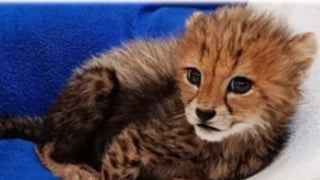Reported By: Srishti Choudhary
Edited By: Apoorva Misra
News18.com
Last Updated: March 30, 2024, 16:38 IST
Madhya Pradesh, India
Mukhi, as it’s popularly called, has spent the last year confined to a separate enclosure away from its mother. (News18)
Captive-born and human-reared, India’s first-born cheetah cub at Madhya Pradesh’s Kuno National Park has turned a year older, but its chances of being freed into the wild are now slim. Born to a Namibian cat last summer, the female cub was rejected by its mother soon after the death of three of its siblings in the deadly heat of May.
The feline Jwala has given birth to four more cubs this January, in addition to eight other cubs born to two other female cats — all bred in captivity. However, wildlife experts apprehend that the hand-reared cub, which has now completed a year in captivity, may no longer stand a chance of being freed into the wild.
“Barring one, all the cubs are being raised by their mothers and kept in very large enclosures. They will do just fine. However, the oldest one, which is being hand-raised, is habituated and very used to being around humans. So, it may not be a very good candidate to be released into the wild. It is certainly difficult and challenging, and is not recommended,” says noted cheetah expert Dr Laurie Marker, who is also the founder of Namibia-based Cheetah Conservation Fund.
When a wild animal becomes habituated, it gets used to human presence, and no longer sees them as potential threats — contrary to the basic nature of large carnivores. Research studies also show that wild beasts classified as ‘habituated’ are declared ‘unfit for release’.
The cub has also missed out on crucial learnings from its mother who would have taught essential survival skills and what dangers to avoid. Some experts argue that cheetahs are born with hunting instincts, but also concur that the cubs raised by mothers stand better chances of survival, than the hand-raised ones.
Mukhi, as it’s popularly called, has spent the last year confined to a separate enclosure away from its mother, who rejected her belligerently. Several attempts to reunite them also failed, and the cub has been taken care of by the veterinarians and support staff that provided food and water and treated it when it got “injured chasing birds”. “Protecting itself from bigger predators and hunting for food require a special set of skills which a cub learns from her mother. Mukhi, unfortunately, misses her mother in providing these skill sets,” say the forest department officials.
Though there have been some successful examples of re-wilding of captive-born cubs in South Africa and Namibia, it is only if they have not become “too habituated”, say experts. “Cheetahs have strong in-born hunting instincts which tell them which prey to go for and when. So they learn to hunt through trial and error. The main concern arises when they start associating their food source with humans during captivity. In this case, they might move closer to human settlements looking for food and do not view them as threats. That is concerning,” said one of the experts, requesting anonymity.
Meanwhile, the freedom of the 11 adult cheetahs also hangs in balance after spending over eight months in the large enclosures in the national park. The wild beasts especially air-lifted from Namibia and South Africa as part of Project Cheetah have not had enough time to explore the wilderness, hone their hunting skills, interact with other predators and learn to breed.
According to senior wildlife biologist and conservation scientist Ravi Chellam, not just the cub, but almost all the surviving adult cheetahs are unsuitable for release after such prolonged captivity. Studies in Africa show that the release of captive-bred or captive-raised large carnivores can be challenging, as the animals show poor survival post-release due to their lacking of the full suite of natural behaviours.
“The Namibian government regulations allow large wild carnivores to be kept in captivity for a maximum of three months, if they are to be released in the wild – unless it is specially required due to veterinary reasons. Failing which the animal will be declared to be permanently captive. The Namibian regulations explicitly prohibit the breeding of such animals in captivity. At Kuno, they have been held captive for over eight months now. Whether large or small, these are still enclosures. The cheetahs are in a protected environment, free of any competing predators. To add to it, we have lost count of how many times these wild animals have been darted, and re-captured, and they are being bred in captivity,” he says.
